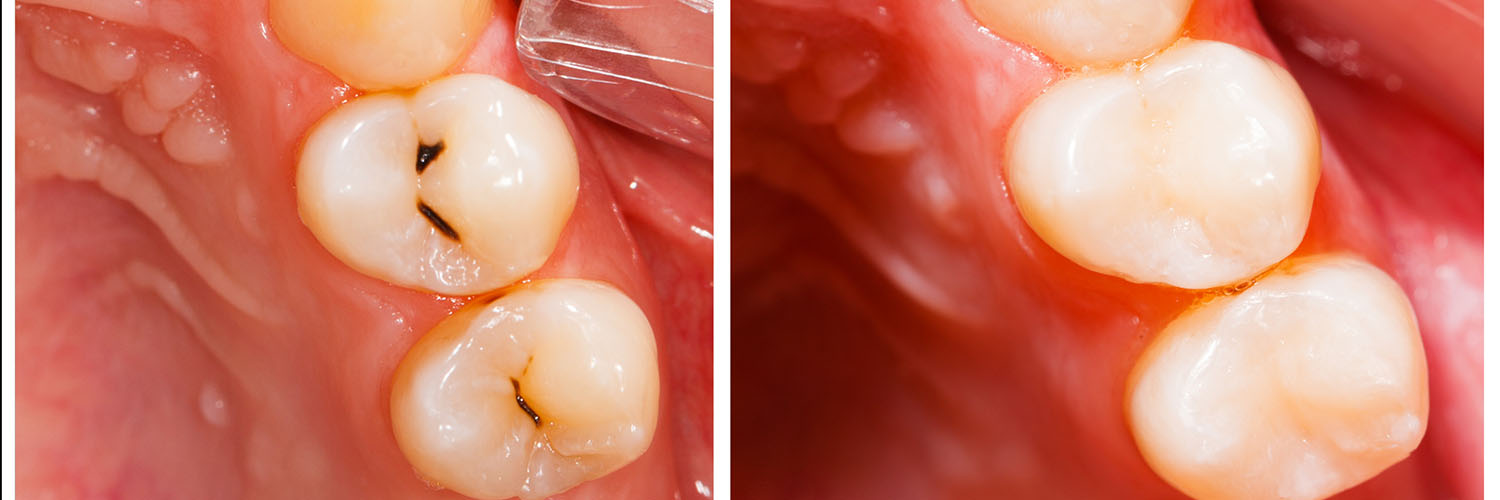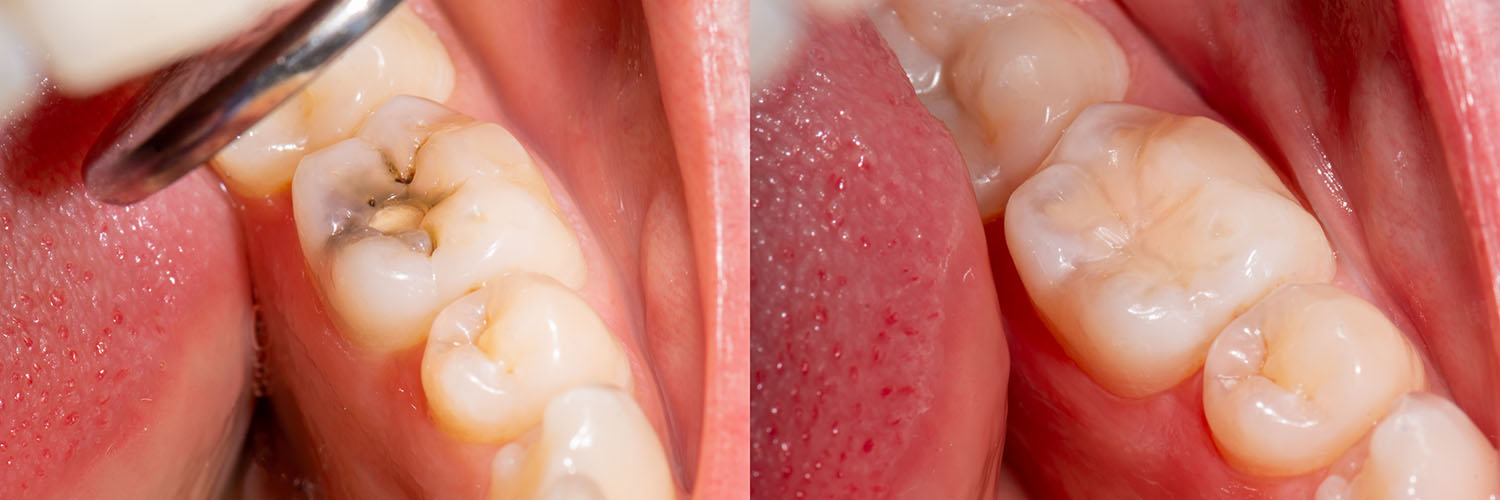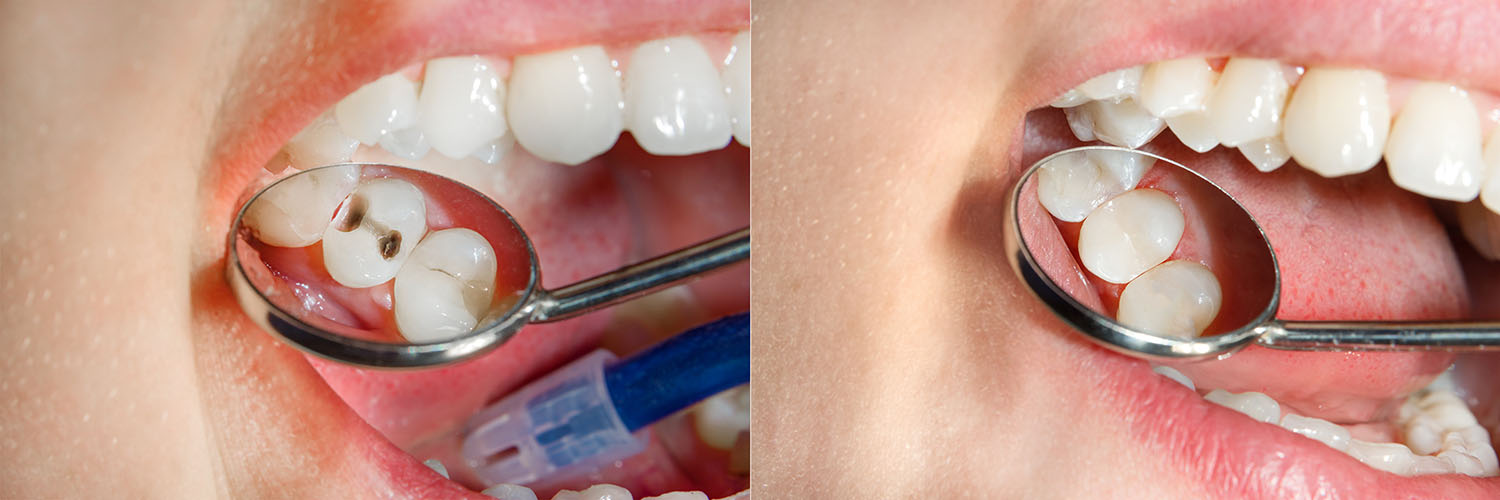
When a cavity or injury removes part of a tooth, a carefully placed filling rebuilds shape, restores strength, and protects remaining structure. Fillings are designed to return a tooth to comfortable function — so you can bite, chew, and speak normally — while minimizing the need for more invasive treatment later on.
Tooth decay remains one of the most common oral health issues for people of all ages, which is why restorations like fillings are among the most frequently performed dental procedures. The goal is always to treat disease early, remove only the damaged tissue, and preserve as much healthy tooth as possible.
Our practice emphasizes precision and patient comfort during every restoration. At Saugeen Shores Family Dentistry, we combine modern materials with conservative techniques so restorations are durable, discreet, and tailored to each patient's needs.
Attempts to treat tooth damage date back thousands of years, but restorative dentistry has advanced dramatically in the last two centuries. Early materials prioritized durability; later developments introduced options that balanced strength with aesthetics and biocompatibility.
Over recent decades, research and improved dental technology have produced tooth-colored materials that bond to enamel and dentin, are free of metal, and blend naturally with the smile. These advances allow clinicians to provide restorations that are both functional and visually pleasing without compromising longevity.
Choosing the right restoration depends on the tooth’s location, the extent of the cavity, and the patient’s expectations for appearance and function. We will explain the advantages of each option and help you select a solution that balances strength, looks, and preservation of healthy tooth tissue.

Today’s restorative toolkit includes several reliable choices. Some materials are best when appearance matters most, while others are ideal when durability under heavy biting forces is the priority. Understanding what each material offers helps you and your clinician choose a restoration you’ll be comfortable with for years to come.
Material selection also reflects the size and location of the cavity, whether the restoration will be placed directly in the mouth or fabricated outside the mouth, and how much natural tooth must be conserved. A tailored approach yields restorations that perform well and look natural.
Below are commonly used restorative materials and the clinical situations where they tend to be favored.
Composite resins are made of a durable polymer matrix reinforced with glass-like filler particles. Available in multiple shades, these materials bond to tooth structure and allow conservative cavity preparation — often requiring less removal of healthy tooth than older techniques.
Because they blend with the surrounding enamel, composites are a popular choice for visible teeth. They can also be shaped and polished to match your natural contours. Like any material, composites may show wear over time and are best maintained with regular dental care.
Amalgam has a long history in dentistry for its durability and resistance to fracture, especially in back teeth that endure heavy chewing forces. While not tooth-colored, amalgam can be a robust option for large restorations where strength is the primary concern.
Glass ionomer materials bond chemically to tooth surfaces and release fluoride, which may help protect against recurrent decay. They are commonly used in areas where aesthetics are less critical, for pediatric restorations, or as temporary or interim fillings while a more permanent solution is planned.
Ceramic restorations, including inlays and onlays, are fabricated from high-quality dental porcelains. They resist staining, match tooth color very closely, and provide excellent long-term wear characteristics. Because they are made outside the mouth and then bonded in place, they are considered indirect restorations and are ideal when a larger portion of the tooth needs restoration without placing a full crown.
Gold alloys remain a gold-standard material in terms of durability and tissue compatibility. Less common today due to cost and aesthetics, gold is still an excellent option when longevity and precise fit are prioritized.

Treatment begins with a careful assessment: a clinical exam, diagnostic images when needed, and a discussion about symptoms and expectations. Once the area is evaluated, your dentist will recommend the most appropriate restoration and explain the procedure so you know what to expect.
When it’s time to place the filling, we use techniques designed for comfort and precision. Local anesthesia is commonly used so the tooth and surrounding tissues are numb during preparation. Depending on the situation, a dental drill, laser, or air abrasion may be used to remove decay while preserving healthy tooth structure.
Direct restorations such as composites or glass ionomer cements are typically placed and shaped in a single visit. For larger or indirect restorations like ceramic inlays or onlays, impressions or digital scans are taken so the restoration can be fabricated and later bonded or cemented in a follow-up appointment.
For patients who feel anxious about procedures, our team will review comfort options and can discuss sedation choices to help you feel relaxed during treatment. Our priority is to provide gentle care and clear communication at every step.
After a filling is placed, most patients return to normal activities quickly. Sensitivity, mild soreness, or a slightly altered bite sensation are common immediately following treatment and usually resolve within days to weeks as the tooth adjusts.
It’s important to protect the softened tissues until numbness fully wears off to avoid accidental biting of the cheeks, lips, or tongue. Routine oral hygiene and periodic professional checkups help monitor restorations and detect any changes early, preserving the health of the tooth over time.
Protect yourself while numb
Local anesthesia can linger for an hour or two; avoid chewing or handling food until feeling returns to prevent accidental injury to soft tissues.
Expect minor differences in bite or feel
Your new filling will be polished and adjusted, but on rare occasions a slight fine-tuning appointment may be needed to perfect your bite and comfort.
Short-term sensitivity may occur
Sensitivity to hot, cold, or pressure is common immediately after treatment and generally fades; if it persists or worsens, please get in touch so we can reassess the tooth.
Maintain your restoration
Routine brushing, flossing, and regular dental visits extend the life of fillings. Even well-done restorations can require repair or replacement over many years if new decay or fracture occurs.
We take pride in providing careful, evidence-based care. If you have questions about your restoration or notice persistent discomfort, reach out and our team will guide you through next steps.

Fillings repair the damage, but preventing new decay preserves long-term oral health. Good daily oral hygiene, a balanced diet low in frequent sugary snacks, and routine professional cleanings are the foundation of cavity prevention for patients of all ages.
In some cases, preventive treatments such as topical fluoride or dental sealants can provide extra protection in vulnerable areas. Your dental team will recommend strategies tailored to your risk factors, oral environment, and lifestyle.
Regular exams allow early detection and simpler, more conservative treatment when decay first appears. Working together with consistent home care and professional monitoring helps keep restorations healthy and reduces the need for more extensive treatment down the road.
In summary, modern dental fillings are designed to restore function, protect tooth structure, and maintain the appearance of your smile. Our team at Saugeen Shores Family Dentistry uses contemporary materials and techniques to deliver reliable, comfortable restorations. Contact us for more information about how we can help restore and protect your teeth.
If the pleasure of eating a delicious bowl of ice cream or sipping a soothing cup of tea gets overshadowed by dental pain that makes you wince; it's time to contact our office. As skilled providers of care, we'll determine what's causing your discomfort and perform the treatment required to alleviate your symptoms and get you back on the road to oral health.
Cavities develop because of an infectious process that causes progressive damage to tooth structure. Despite starting as a pinpoint defect on the outermost enamel layer of your tooth, untreated dental decay progressively compromises more and more healthy tooth structure as it works its way to the inner layers of your tooth.
Yes, you can still develop tooth decay on other surfaces of the tooth, around the margins of an old filling, or in fewer instances, recurrent decay underneath it. For this reason, it's essential to maintain excellent oral hygiene, a diet low in sugary beverages and sweets, and be sure to visit our office for routine checkups and care. While tooth decay is second only to the common cold in frequency, it's almost entirely preventable.
We value the time and comfort of our patients. If cavities are located on adjacent teeth, or in the same section of your smile, it may be possible to treat more than one tooth during your visit. However, how much is done each visit depends on several factors. We keep our patients well informed and tailor every treatment plan and visit to address their unique needs.
Addressing concerns on the presence of elemental mercury in silver fillings, the American Dental Association (ADA), The Center for Disease Control and Prevention (CDC), the FDA, and the World Health Organization have all stated that amalgam restorations do not pose a risk to health. However, individuals with allergies or sensitivities to the metals in dental amalgam are advised to pursue other restorative options.
Dental fillings are performed under local anesthesia to help ensure your comfort throughout the entire procedure. The involved tooth remains completely numb for the extent of your visit. Within one or two hours after the procedure is completed, the local anesthetic will gradually wear off, and normal sensations return.
A tooth-colored composite filling is fully hardened and set by the end of your visit. However, we may advise you to wait a couple of hours until the local anesthesia has completely worn off. This advice is to help ensure you don't accidentally bite your lip, cheek, or tongue while still numb.
The lifetime of a dental filling varies depending on the type of material used. While popular dental materials can last a decade or more with proper care, they can degrade over time, wear down, or even break. When this happens, you may experience some tooth sensitivity, a jagged edge, or a loose or dislodged piece of filling material. Whatever the case may be, it's essential to get the filling replaced before the tooth sustains further damage or other consequences arise. Beyond taking good care of your smile to help ensure the longevity of your fillings, our office regularly checks the status of your existing fillings as part of a routine checkup exam.
Dental fillings are an essential investment that serves to preserve and protect the health of your smile. With that said, how much a filling costs depends on the number of surfaces of the tooth involved and the filling material that is used. Amalgam restorations are the most economical. While tooth-colored composite fillings have a slightly higher cost, they offer the added benefits of being metal-free and much more aesthetically pleasing. Ceramic fillings, inlays, and onlays are more expensive than the preceding options but provide outstanding, long-lasting, and natural-looking results.
Dental insurances typically cover the cost of dental fillings. While we work with you to maximize your insurance benefits, there may still be an out-of-pocket expense. At the office of Saugeen Shores Family Dentistry, we strive to help you begin care without any additional financial stress or delay.
Dental fillings are restorative materials used to repair a tooth that has been damaged by decay or minor fracture. They restore the tooth's natural shape, seal off sensitive areas, and help the tooth regain normal function for chewing and speaking. Fillings can also prevent further breakdown of tooth structure when decay is removed and the cavity is properly restored.
Because dental caries remains a common condition across all ages, placing fillings is a routine part of dental care aimed at preserving natural teeth. Treatment strategies focus on removing infected tissue, protecting the remaining tooth, and choosing a filling material that balances strength and appearance. At Saugeen Shores Family Dentistry, we emphasize conservative restorations that maintain as much healthy tooth as possible while delivering durable results.
There are several widely used filling materials, including composite resins, dental amalgam, glass ionomer cements, ceramic inlays/onlays, and gold restorations. Composite (tooth-colored) fillings are popular for visible areas because they match natural enamel, while amalgam has been used for decades where maximum durability is required. Glass ionomers release fluoride and can be useful in specific situations, and ceramic or gold inlays and onlays are indirect options for larger restorations.
Direct fillings such as composite and amalgam are placed in a single appointment, while indirect restorations like ceramic inlays and onlays are fabricated outside the mouth and cemented later. The best material depends on the tooth's location, the extent of the decay, aesthetic priorities, and functional demands. Your dentist will review the clinical factors and recommend an option that meets your needs and expectations.
Filling placement begins with a thorough examination and X-rays as needed to assess the extent of decay. The area is numbified with local anesthesia to ensure comfort, and the dentist removes the decayed or weakened tooth structure using a drill, laser, or air-abrasion tool. Once the cavity is prepared, the tooth is cleaned and conditioned to receive the chosen restorative material.
Placement technique varies by material: composites are bonded in layers and cured with a light, while amalgam is condensed into the prepared space and carved to shape. Indirect restorations require impressions or digital scans and may involve a temporary restoration before final cementation. The dentist will check and adjust your bite, polish the filling, and provide aftercare instructions before you leave.
Immediately after a filling you may have residual numbness from the local anesthetic, so avoid chewing until normal sensation returns to prevent accidental biting of the lip, cheek, or tongue. For the first 24 hours, be mindful with hot foods and sticky substances if you received a temporary or newly placed restoration. If you were given specific instructions about eating or medications, follow those directions closely.
Maintain good oral hygiene by gently brushing and flossing around the restored tooth, and avoid aggressive flossing that could disturb the contact until the restoration is fully set. Short-term sensitivity to hot, cold, or pressure is common and typically resolves within days to weeks. If sensitivity worsens, you experience persistent pain, or the filling feels unusually high, contact the dental office for reassessment.
It is normal for a restored tooth to feel slightly different for a short time as the nerve adjusts to the treatment and the new surface contours settle. Some patients notice sensitivity to cold, sweet foods, or biting pressure; this usually diminishes over a few days to a few weeks as the tooth recovers. Minor adjustments to the filling or bite can be made in the office if the restoration feels uneven when you chew.
Persistent or increasing sensitivity, sharp pain with biting, or lingering discomfort beyond a few weeks should be evaluated, since these signs can indicate issues such as an improperly contoured filling, secondary decay, or a deeper nerve problem. Your dentist can perform tests to determine the cause and recommend appropriate follow-up treatment. Timely communication helps avoid complications and preserves the health of the tooth.
The lifespan of a filling depends on the material used, the size and location of the restoration, oral hygiene habits, and functional stresses such as grinding. Composite and glass ionomer restorations may last many years with proper care, while amalgam and ceramic restorations can last longer in high-stress areas. Daily oral care and regular dental examinations play a major role in maximizing the longevity of any restoration.
Fillings should be evaluated during routine dental visits for signs of wear, margin breakdown, recurrent decay, or fracture. If a filling shows gaps at the edge, darkening around the restoration, or causes discomfort, it may need repair or replacement to prevent further tooth damage. During recall exams at Saugeen Shores Family Dentistry, your dentist will monitor restorations and recommend timely care to maintain oral health.
Composite fillings are tooth-colored materials that bond to the remaining tooth structure and allow for more conservative preparation, making them ideal for visible teeth or small to moderate cavities. They offer excellent aesthetics and can be matched to the natural shade of enamel, although they may be more susceptible to wear and staining over many years. Composites also require moisture control and careful layering during placement to achieve optimal strength.
Amalgam fillings are metallic restorations known for their durability and resistance to heavy chewing forces, which historically made them a common choice for posterior teeth. They typically require removing more tooth structure to create a stable form for retention, and their silver appearance is less aesthetic than tooth-colored alternatives. Both materials remain clinically effective, and your dentist will weigh functional and cosmetic considerations when suggesting an option.
A crown or onlay is recommended when a tooth has extensive decay, large previous restorations, or significant structural weakening that compromises long-term durability. These indirect restorations cover more of the tooth surface and distribute biting forces more effectively than a conventional filling, which helps prevent fracture and further breakdown. Onlays and crowns are commonly chosen for teeth with large cavities, cracked cusps, or when a conservative filling would not provide sufficient strength.
The process typically involves preparing the tooth, taking an impression or digital scan, and fabricating the restoration in a dental laboratory or using in-office milling systems. A temporary restoration may be placed while the final piece is made, and the permanent onlay or crown is then cemented or bonded in place. Your dentist will explain why an indirect restoration may be the most predictable choice for preserving the tooth long term.
Dental materials in use today have been studied extensively, and regulatory bodies consider commonly used restorative materials safe for the general population. Amalgam fillings contain an alloy that includes mercury, but when set as a dental restoration they form a stable material; numerous health agencies have concluded that dental amalgam is a clinically effective material for many patients. For those who prefer alternatives, there are mercury-free and metal-free options such as composite, glass ionomer, and ceramic restorations.
Material selection also considers biocompatibility, allergies, and patient preference, and your dentist can discuss any concerns you may have. If you have a specific medical condition, metal sensitivity, or environmental considerations, the dental team will review alternatives and choose a suitable restorative plan. Open discussion ensures you receive a restoration that aligns with your health needs and personal priorities.
Preventing cavities starts with a consistent oral hygiene routine that includes brushing twice daily with fluoride toothpaste, flossing daily, and using adjuncts such as fluoride rinses when recommended. Diet plays a crucial role; limiting frequent exposure to sugary and acidic foods and beverages reduces the fuel for decay-causing bacteria. Professional measures such as regular cleanings, fluoride treatments, and dental sealants for vulnerable surfaces can further lower your risk, especially for children and patients prone to cavities.
Additional preventive strategies include wearing a mouthguard if you grind your teeth, addressing dry mouth that can increase decay risk, and attending routine dental checkups so early problems are detected and managed promptly. Your dental team can create a personalized prevention plan based on your oral health, lifestyle, and risk factors to help keep natural teeth healthy for life.
Quick Links